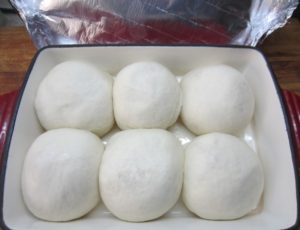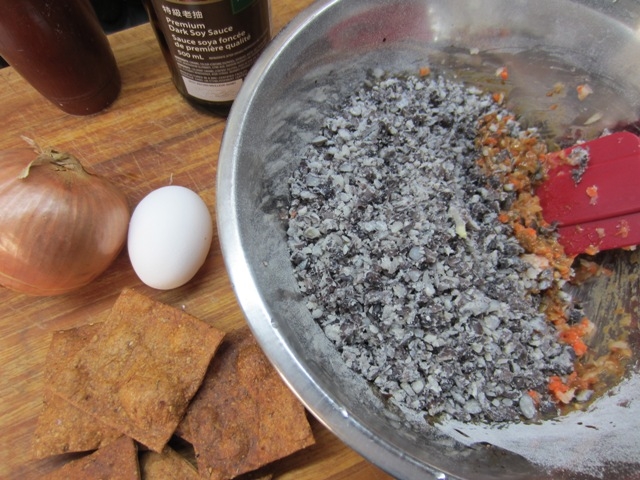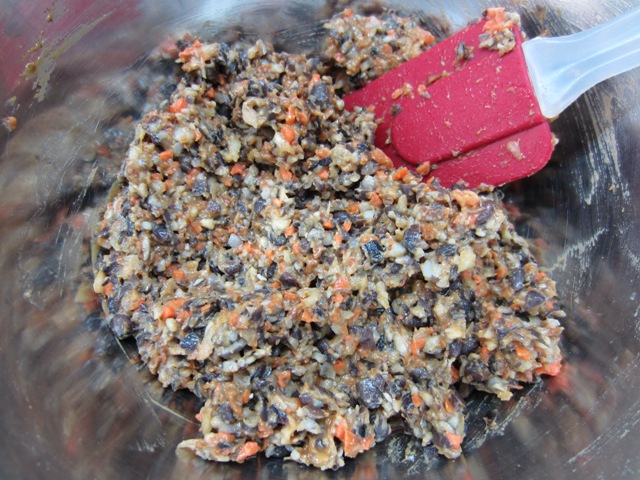Happy Canada Day grill warriors! Bringing you the best in beavers and maple syrup for 150 years.
Making a vegetarian “burger” can be an exercise in frustration and disappointment. The first problem is right there in the name. It sets false expectations rarely met which is a real shame because if they were called “traditional bean cakes on soft brioche” from some obscure country at the top of current culinary popularity polls people would eat them happily and enjoy every last bite. When you consider the typical ingredient list, they’re not that far from falafel which everyone already loves. That you shove them in a bun and decorate with burger-like extras shouldn’t detract from the fact that they taste great.
I do enjoy a traditional burger straight off the charcoal from time to time. Quality beef fresh from the grinder and gently formed makes the classic to top simply with tomato, lettuce, & spicy mayo. Mince pork with chiles & onions topped with grilled pineapple in a sweet Hawaiian bun works too. Slather a lamb burger with garlic oil and top with feta if you’d like. A million variations attest to the global obsession with meat in a bun. My trick of the day however is that you can make a hand-feast equally as delicious without any meat at all. For vegetarian training wheels feel free to make a batch ‘half veggie’ by mixing in some percentage of meat. It will stretch your budget instantly and over time you’ll likely find that you need less and less to be satisfied more and more.
Before I dive into the deep end of yet another online veggie burger recipe I should stop to say that if it comes down to grilling one of the industrially formed sponges marketed by the ‘meat analogue’ complex, I’d rather skip the burger altogether and roast something different for dinner. I have no problem with soy or other substitutes when used in tasty ways but I’ve yet to find a ‘convenience burger’ from the dozens of brands out there (Amy’s, Yves, Morningstar, Gardein, etc.)* that really stands up well to flavour scrutiny. You pay dearly for those factory-concocted creations and homemade versions outperform on the cheap without the laundry list of unpronounceable ingredients. About twenty cents each if my math is correct compared to oftentimes more than two bucks each with the boxed alternatives. The industry has found there’s gold in meat substitutes and someone (you) has to pay for all those fancy pressing machines and fake-meat scientists. Taste matters most and homemade easily wins on that score. The only real hurdle you face is texture. Curse those pesky meat expectations but I have a few tricks up my sleeve to help that centre on keeping the mixture relatively dry and a clever final coating that crisps up perfectly.
* Here in my rural corner of Canada, the well-reviewed Quorn brand from the UK has yet to make an appearance. It’s based on a wholly different ingredient (mycoprotein) which could be a game changer but no matter how good it tastes it will be crazy expensive here.
I’ve got at least five versions of a ‘meatless burger’ made with all manner of ingredients ranging from brown rice to mushrooms to tofu. All of them worth real estate on your buns but with varying degrees of satisfaction on the ‘is this as good as a burger?’ scale. Again, the first step to making a good veg burger is to set your expectations properly. If you stack a soft homemade bun with interesting condiments, garden pickings, sauteed mushrooms, gooey cheese, and a patty made right, it’s going to taste fine. Instead of ‘missing the meat’ try to enjoy the taste that’s already there.
One of the old drums people bang on with homemade versus frozen ready-made is convenience but the fact that you can make a big batch of these ahead and chill or freeze them for speedy weeknight cooking eliminates any such grumbling. If you’ve got cabbage for a quick coleslaw or potatoes for a gratin (ok, yes, you can make chips too), and a batch of buns from the weekend, this meal is ready in fifteen minutes.* Cooking the patties from frozen is a no-brainer and of course safe since there’s no meat involved.

* My quick-to-oven version of fresh hamburger buns actually get more moist and pliable with a few day’s age if you park them in sealed plastic while still barely warm… but those details are for another post. Use store-bought or go bun-less if you must. The patties can even be layered with tomato sauce and obscene volumes of melted cheese for a tray bake twist in the vein of chicken Parmesan.
Personally I always take the ten minutes to start a charcoal fire for finishing flavour but get an impressive initial crust with oil in a frying pan to start the cooking process and firm up the patties properly. You can of course cook in a pan from start to bun. If there is any trick it’s to move them as little as possible (two flips max) and seriously char the outsides. Practically burn them if you want to fake a meat burger successfully.
Speaking of crust, the coating trick I use for all my veg burgers is potato flakes. Plain old instant mash is usually 100% pure and while it won’t make very good potatoes, the dehydrated flakes coat and crisp up perfectly. I keep a box solely for veg burgers and making potato bread buns to match. Keep filler ingredients to a minimum but add healthy doses of soy, Worcestershire, and BBQ sauce for a depth of taste. A scant few drops of liquid smoke or spices like cumin and paprika are optional but potent additions should you choose.
Onion & carrot grated or diced finely add good body to the black beans which I cook from dry myself so that I can stop while they still have the right firmness for the task. You’re not trying to make re-fried beans and this is why tinned beans don’t work as well here. They’ll fall to mush. Courgettes are often called for in veg burger recipes but I’ve found they don’t add much flavour and tend to be too wet. With all ingredients that dry nature is critical to getting a patty to form instead of the lot falling apart into crumbles – a tasty technique for other dishes mind you. I take the time after cooking and draining my black beans to lay them on a sheet pan and refrigerate to dry completely before careful pulsing in the food processor (see texture photo below). Crackers or corn chips crushed very fine absorb any residual surplus moisture better than heaps of flour and again add good texture. Eggs are the final binder to hold it all together but one is plenty amongst six patties lest you make mutant omelette burgers.
Interesting variations include chopped parsley, coriander leaf, or lemon zest. You can also dry roast corn kernels and chiles to dice into the mix or even stir in small cubes of relatively dry halumi. Well-drained feta cheese was another experiment and while a reasonable idea, I found the flavour a bit too distracting. I’d rather save it for my feta and melon salad and find some Gruyere to melt on top afterward. Just remember to keep additions as dry as possible to prevent disintegration in the pan. Anything you want in there that’s too wet is a likely candidate to add to the the top after cooking; fire-roasted red peppers and grilled mushrooms cut into fat slices for example which are at the top of my favourites list.
Black Bean “Burgers”
250 grams dry black beans, soaked in ample cold water overnight
50 grams dry crackers or corn chips
1 large egg from a happy chicken
1/2 medium carrot, shredded or diced fine
1/2 yellow onion, diced fine
1 tablespoon flour or cornstarch
1 tablespoon dark soy
1 tablespoon Worcestershire sauce
2 tablespoons BBQ sauce, homemade preferred
2 cloves fresh garlic, minced
1/2 teaspoon fine sea salt
1/2 teaspoon freshly ground black peppercorn
1/2 teaspoon dry red chile flakes (optional)
2 drops liquid smoke (optional)
1 teaspoon toasted & freshly ground cumin seed (optional)
1 teaspoon paprika, any variety (optional)
1/2 cup dehydrated potato flakes
Yield: Six veg patties. Recipe can be multiplied up to four times.
In enough well-salted water to cover by double, bring the black beans to a boil then reduce to simmer until barely tender, about forty minutes. Don’t overcook the little black devils and leave them on the firmer side of done. Drain well, rinse, and place in a single layer on a sheet pan to cool and dry in the refrigerator for at least an hour. This can be done up to two days ahead.
In the bowl of a food processor fitted with a standard blade, place the crackers or corn chips and pulse until very finely ground. Add the cooled beans and pulse only until coarsely ground. Remove to a large mixing bowl.
In a separate bowl whisk the egg briefly then add all remaining ingredients except potato flakes. Whisk to combine then add to the beans and stir well. Refrigerate for at least another twenty minutes and up to a day ahead to allow the flavours to permeate and the mixture to firm slightly. *If your mix is somewhat wetter than necessary and you’re in a hurry, a few tablespoons of the dehydrated potato flakes can be added directly to help absorb moisture.
Form patties with roughly 100g of the mix for each remembering that these patties will not ‘shrink’ like meat when cooked. Press both sides into the potato flakes spread on a large dish then move to a baking rack to sit for ten minutes. Press into the flakes again then return to the rack. Proceed to cooking in a lightly oiled pan over medium-high heat or brush liberally with oil before grilling over delicious charcoal or wood. Did you hear me? Stay away from that nasty propane business.
You can also freeze the patties in a single layer after forming for later use which gives firmer results to the final burgers. Store fully frozen patties between squares of parchment paper in a tightly sealed bag for up to two months.
Use good buns, accessorize with wild abandon. Maybe make some good chips and proper coleslaw while you’re at it.



